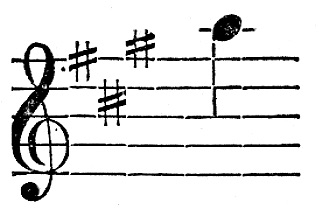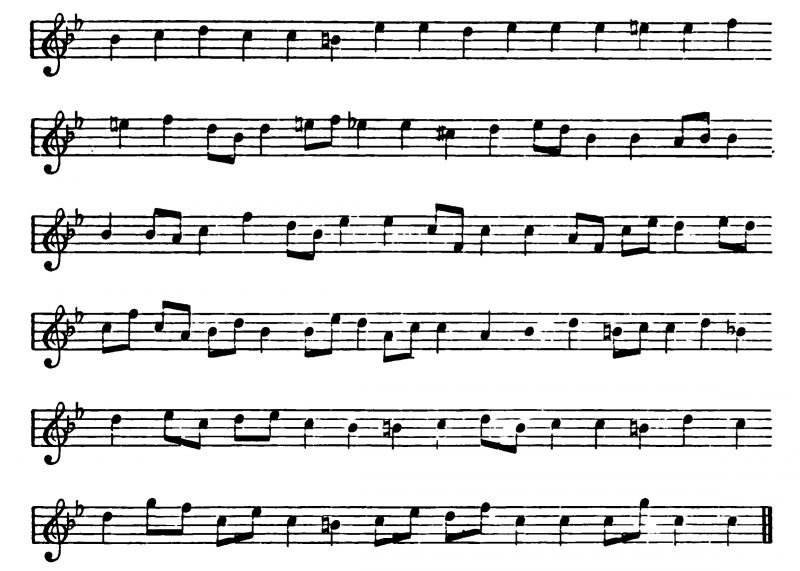Picture a man climbing the stairs of the Royal Exchange in London—this is in the old days of the grand stone building, before it burned down, in 1838—and imagine him ascending to the high gallery, up among the lottery booths, the mathematical-instrument makers, the Merchant Seaman’s Office and the Lloyd’s Subscription Coffee House. Over the railing and down in the quadrangle below, around the courtyard statue of Charles II, are moneylenders and merchants of the exchange: noise roils up from them.
Our observer in the gallery is a diminutive man, with a searching look, and he may be scratching his curly white locks as he listens; he may be wearing his old favorite frilly-fronted shirt. And he focuses intently—not on stock tips or on any specific words at all, but rather on the aggregate sound.
And he may note it as part of his ongoing project—the notes he is taking for his book—labeled The Music of Nature.
This crowd, he decides, is in the key of F.
There is no accounting, really, for a mind like William Gardiner’s. He was born to a Leicester hosiery-maker, and raised to take over his family trade; one of his earliest recollections was going to an immense orchestral benefit concert in 1774, at the age of four, and being taken into the orchestra by his indulgent father. The boy sat by the fourth Earl of Sandwich—yes, that one—and was transfixed as the Lord walloped enthusiastically at some kettledrums. The boy’s course for the next seventy years was now set: his living would be making stockings, but his life was in making music.
When Gardiner is remembered today, it’s for a fortuitous act of musical appreciation: In 1794, Abbé Döbler, a musician in political exile from Cologne, was sheltering in Leicester and stopped by to see the young stocking-maker. He’d heard Gardiner was a great music-lover, and showed him a violin trio in E-flat written by a still-obscure young acquaintance back home. Gardiner was so utterly taken with it that he arranged a local performance. The unknown composer was Ludwig van Beethoven—and the performance was quite possibly the first of his work outside his native country.
But if the young stocking-maker had been one of the first to stumble onto the landmark genius of his age, haunting the galleries of the Royal Exchange was a more deliberate project—a different sort of musical appreciation altogether.
For William Gardiner wanted to change not whom we hear, but how we hear.
Gardiner’s magnum opus, published in 1832, gives you a clue to its peculiarity the moment you open it: a hand-tinted frontispiece represents, through a prismatic set of stacked ovals, “the shape and color” of wind instruments. If your eyebrows weren’t raised by this Regency-era synesthesia, they would be by the facing title page: The Music of Nature, Or, An Attempt to Prove That What Is Passionate and Pleasing in the Art of Singing, Speaking, and Performing Upon Musical Instruments, Is Derived From The Sounds of the Animated World.
“The author of the following pages has been in the habit of listening to sounds of every description, and that with more than ordinary attention…,” he begins modestly in his preface. “The novelty of the subjects may claim for this book some attention.”
The notion of analyzing and even transcribing uncomposed sound has a few precursors—the English monk John of Fornsete rendered a cuckoo call in a manuscript in 1226, and in 1650 the reliably inquisitive Athanasius Kircher transcribed a number of bird calls in his gorgeously illustrated Musurgia Universalis. Gardiner went further, though: he gamely tried his hand not only at nightingales and ducks, but also at everything from kittens mewling and cows mooing to—startlingly—a “Child sobbing”:

One can only imagine the stocking-maker patiently listening to a weeping child, humming along to make sure he’s got the tune right, and then plinking at a piano upon getting home: heu-é heu-é heu-é.
But then, Gardiner pointed out, we all rely in our daily lives on distinguishing pitch—and not just in listening to the living. Gardiner was also fascinated with the sound of ordinary objects, like ringing true and counterfeit coins against a tabletop: “Half crowns having the sound of—

—bankers quickly discover the least deviation from the proper tone, by which they readily detect the counterfeits,” he wrote.
What Gardiner’s readers found—tucked in amid a perfectly serviceable book on basic musical concepts and appreciation—was an extraordinary scattering of transcriptions for sounds like a young lady calling, a counterfeit shilling, and this:

And, of course, there’s his observation of the preference for the key of F among the moneylenders on the Royal Exchange—a phenomenon noted, I might add, in a chapter on insects. (He is, of course, comparing them to a beehive.)
It’s easy to imagine Gardiner at work on these transcriptions, because we can actually hear him at work. Here’s his notation for the sound of a loom making a stocking:

The Music of Nature is about music in the way that The Anatomy of Melancholy or Religio Medici is about medicine: that is, it is an extraordinary digressive meditation. His musical scholarship is no more reliable today than Burton’s medical advice, and yet how can one not be charmed by a text that observes that a glass of flat champagne rings with a purer tone than a bubbly glass does? What parent would not agree that “Providence has bestowed upon children a power of voice, in proportion to their size, ten times greater than that of an adult”? Who would not want to believe his wonderful claim that “in a watchmaker’s shop the timepieces or clocks, connected with same wall or shelf, have such a sympathetic effect… that they stop those which beat in irregular time”?
The book found both champions and enemies: one British reviewer pronounced the book “a very curious one; very eccentric, very original, very desultory, very entertaining, very erroneous, and very instructive,” while another called it “stupid and driveling,” and more or less denounced Gardiner for dragging music into the dirt and dust.
That, as it turned out, was just where some scientists and philosophers liked it. Darwin’s notebooks a few years later include quotes from Gardiner; Ralph Waldo Emerson was copying numerous passages from The Music of Nature into his notebooks in 1837, just as he was first meeting Thoreau. Emerson passed a copy along to Margaret Fuller, who was so delighted that she cited it in her lectures as a transcendentalist text, leaving one skeptical student wondering at a book that “appears to show there is music in everything, even in the screams of a child, or cackling of a hen.”
But that’s just what The Music of Nature tried to do. Whether Gardiner is pondering orioles or oboes, every page gives the sense of the world viewed entirely through a musical prism—and by a man who, Emerson noted dryly, “thinks the best result of the Thirty Years’ War was the perfecting of wind-instruments.”
Gardiner never did gain much fame beyond his small circle of transcendentalist admirers; the last print edition of The Music of Nature, rather fittingly, was made in Boston in 1860. Another century would pass before musique concrète gained currency, and Gardiner never really had much interest in concrete composition and arrangement: to him, natural sounds without accompaniment conveyed the musicality of the world. His one true heir might be Simeon Pease Cheney, an obscure New England music teacher who died in 1890 at the age of seventy-two with a desk full of transcribed birdsongs.
What Cheney’s children published a year later, Wood Notes Wild, is one of the most curious collections I’ve ever come across—where else are you liable to be reminded that robins are fond of singing triplets? But Cheney was reaching for more: he’d taken sheaves of notes on the work of Kircher and Gardiner and other sources, and planned to write “on the music of inanimate things”—but then died before he could finish his project.
“I have been delighted with the music of a door as it swung lazily on its hinges, giving out the charming tones resembling those of a bugle,” the old music master mused in his one surviving passage on object sounds. A rotary clothesline spinning in the wind, he writes, can “whirl out a wild melody in the purest intervals”:

The one hint of how much further Cheney might have gone is from his only other object transcription: water dripping into a half-filled bucket. It is a melodic progression that normally passes without notice, and transcribing it is a task that is patient, unadorned, and appreciative. It is, perhaps, the best memorial that one could write to William Gardiner:





